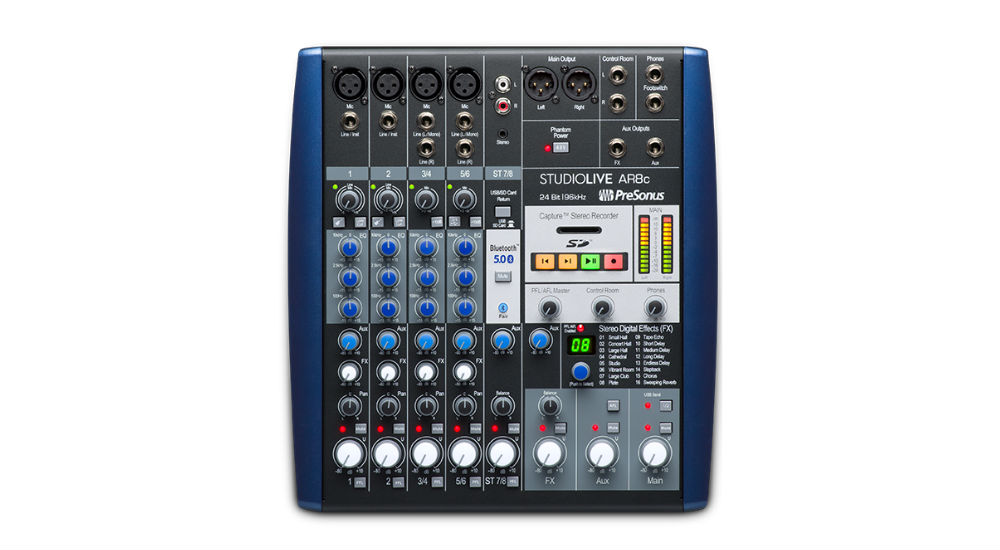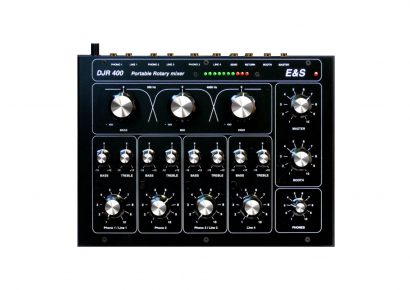There’s freedom to mix on the fly before recording everything from podcasts to live sets and studio sessions, and you’ve got the option of tracking each individual channel alongside the main mix. As always, PreSonus make sure to provide a logical and compact workflow with each button or knob having only a single function.
The sizable fader knobs gift -80dB to +10dB range for each channel as well as independent FX and aux mix control. The StudioLive AR8c comes with four XLR mic inputs each with a high-gain XMAX-L mic preamp and 48V phantom power – perfectly designed for podcasters that frequently have additional guests and are in need of multiple microphone setups.
The interface itself delivers 24-bit/96 kHz audio, and you have an initial 12dB to 55dB variable gain knob before a responsive three-band EQ. Every channel has its own AUX, FX, pan and mute control as well as a PFL (pre-fade listen) button. This is excellent for figuring out how much headroom you’ve got on a channel before fading in with the AUX, FX or rest of the mix– note that it does not bypass the channel’s EQ.
For musicians, inputs one and two also have an instrument/line in. You’ve got low cut and a substantial gain boost added at the press of a button without sacrificing quality sound. You can really crank up the volume after tracking and hear how crisp and clear the recording is with such little noise present.
Inputs 3/4 and 5/6 can instead take dual 1/4” jacks for stereo or mono recording. These inputs also feature a +10db gain at the press of a button. Channel 7/8 provides you with a stereo 3.5mm jack or dual RCA input – ideal for playback through samplers, record players or synth modules. Furthermore, Bluetooth wireless connectivity is also included so you can remotely play music off your choice of device.
The list of 16 onboard digital effects is tastefully included, with reverbs and delays as well as a slick tape echo and chorus. You’ve got complete control over the blending of these effects into each channel, which is a nice touch for a live setting and PreSonus have done well not to overdo it with token effects that you’ll never want.
USB-C connectivity means you can hook up the interface to nearly any computer and record through your choice of DAW – Presonus’ Studio One Artist is included with the purchase of the mixer. Alternatively, using the onboard stereo recorder you can record the main mix straight to an SD card without the need of a computer. Simply press the USB/SD button to swap between playback sources. I can see why this may appeal to some people and it’s definitely a good back up plan to have. However, you’ll tend to need a laptop at some point during the production process anyway, and everyone seems to have one on hand these days, so I don’t see this as being a huge drawcard.
Despite being one of the smallest Presonus products, this unit is a bit bulky overall, although, when you weigh it up against the quality of the preamps it shouldn’t be a problem. It would probably best suit musicians, particularly in small bands, that are often playing in different locations, as well as home studio artists that want to upgrade from a simple two channel interface. The analogue/digital hybrid gives you much better control over the tracking process and the option of playing live. Also, for monitoring purposes you can playback up to four streams of previously recorded tracks. But as I mentioned, you’ll need to find a good bit of extra desk space.
In any case, I am yet to see PreSonus sacrifice quality of sound in any of its products, you cannot be unhappy with what this unit can deliver.

